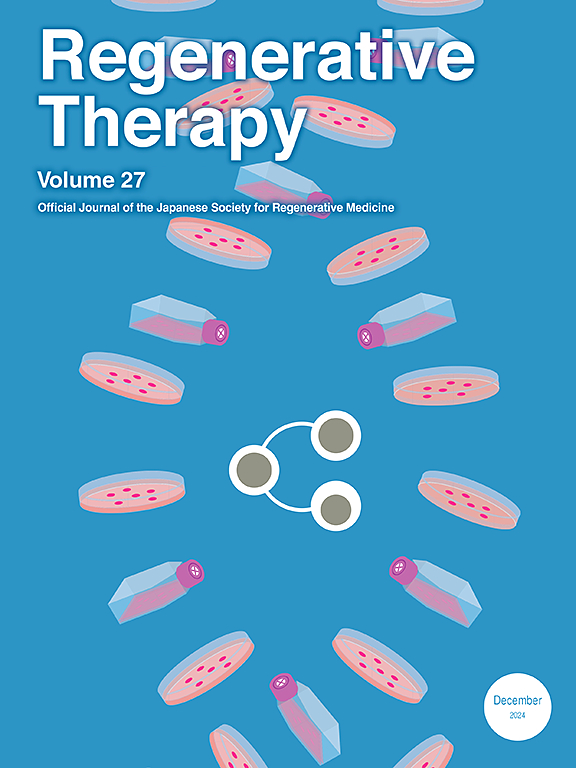富血小板血浆源性外泌体通过激活Wnt/β-Catenin信号通路刺激毛囊生长
IF 3.4
3区 环境科学与生态学
Q3 CELL & TISSUE ENGINEERING
引用次数: 0
摘要
雄激素性脱发(AGA)是一种常见的脱发类型,影响着全球很大一部分人口,严重影响个人的外表和心理健康。现有的治疗方法如米诺地尔和非那雄胺的效果有限,并可能引起副作用,这突出了替代疗法的必要性。目的探讨富血小板血浆源性外泌体(PRP-Exos)在促进毛囊生长和人真皮乳头细胞(DPCs)增殖中的作用,并探讨其机制。方法采用纳米颗粒跟踪分析(NTA)、透射电子显微镜(TEM)、Western blotting等技术对sprp - exos进行分离鉴定。通过CCK-8测定PRP-Exos对DPC增殖的影响,通过Transwell迁移和划伤愈合测定评估PRP-Exos的迁移。流式细胞术分析细胞周期进展。采用毛囊器官培养法检测PRP-Exos对毛囊生长的影响,并在小鼠模型上进行体内实验,评估PRP-Exos对毛囊生长的影响。结果CCK-8、Transwell迁移和抓伤愈合实验显示,dpcs内化PRP-Exos可显著促进其增殖和迁移。流式细胞术显示,PRP-Exos促进了DPCs细胞周期的进展。此外,PRP-Exos处理导致β-Catenin和left -1水平升高,SFRP1表达降低,表明Wnt/β-Catenin通路被激活。毛囊器官培养表明毛囊生长增强,毛囊生长期延长,延缓了向休止期的过渡。体内研究表明,小鼠皮肤厚度增加,毛囊直径增加,生长与休止期的比例增加,促进了毛发在休止期的生长。结论sprp - exos通过激活Wnt/β-Catenin信号通路刺激毛囊生长,有望成为AGA的治疗选择。提示PRP-Exos在体外和体内均能促进毛囊再生。本文章由计算机程序翻译,如有差异,请以英文原文为准。

Platelet-rich plasma-derived exosomes stimulate hair follicle growth through activation of the Wnt/β-Catenin signaling pathway
Background
Androgenetic alopecia (AGA) is a common type of hair loss that affects a large segment of the global population, significantly influencing individuals' appearance and mental health. Existing treatments like minoxidil and finasteride have limited effectiveness and can cause side effects, highlighting the need for alternative therapies.
Objective
This study aims to explore the effectiveness of platelet-rich plasma-derived exosomes (PRP-Exos) in stimulating hair follicle growth and the proliferation of human dermal papilla cells (DPCs), as well as to investigate the mechanisms involved.
Methods
PRP-Exos were isolated and characterized using techniques such as nanoparticle tracking analysis (NTA), transmission electron microscopy (TEM), and Western blotting. The impact of PRP-Exos on DPC proliferation was measured using CCK-8 assays, while their migration was assessed through Transwell migration and scratch wound healing assays. Flow cytometry was used to analyze cell cycle progression. Hair follicle organ culture was employed to examine the effects of PRP-Exos on hair follicle growth, and in vivo experiments were conducted in a mouse model to assess the influence of PRP-Exos on hair follicles.
Results
DPCs internalized PRP-Exos, which significantly boosted their proliferation and migration, as shown by CCK-8, Transwell migration, and scratch wound healing assays. Flow cytometry revealed that PRP-Exos facilitated cell cycle progression in DPCs. Furthermore, treatment with PRP-Exos resulted in increased levels of β-Catenin and Lef-1, along with decreased expression of SFRP1, indicating activation of the Wnt/β-Catenin pathway. Hair follicle organ culture indicated enhanced hair follicle growth and a prolonged anagen phase, delaying the transition to the telogen phase. In vivo studies demonstrated increased skin thickness, hair follicle diameter, and a favorable anagen-to-telogen ratio in mice, promoting hair growth during the telogen phase.
Conclusions
PRP-Exos show promise as a therapeutic option for AGA by stimulating hair follicle growth through the activation of the Wnt/β-Catenin signaling pathway. These findings suggest that PRP-Exos could enhance hair follicle regeneration both in vitro and in vivo.
求助全文
通过发布文献求助,成功后即可免费获取论文全文。
去求助
来源期刊

Regenerative Therapy
Engineering-Biomedical Engineering
CiteScore
6.00
自引率
2.30%
发文量
106
审稿时长
49 days
期刊介绍:
Regenerative Therapy is the official peer-reviewed online journal of the Japanese Society for Regenerative Medicine.
Regenerative Therapy is a multidisciplinary journal that publishes original articles and reviews of basic research, clinical translation, industrial development, and regulatory issues focusing on stem cell biology, tissue engineering, and regenerative medicine.
 求助内容:
求助内容: 应助结果提醒方式:
应助结果提醒方式:


